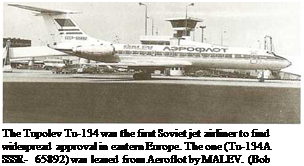Short-Haul Jet
![]()



![]()
Workhorse for the Seventies
While the giant Tupolev Tu-114 was making headlines during the latter ‘Sixties with its trans-Atlantic and long-haul services to east Asia, another aircraft from the same Design Bureau entered the Aeroflot scene rather quietly. Produced at Kharkov, the Tupolev Tu-134 was a much-modified Tu-124, so modified, in fact, with engines moved to external nacelles at the rear and vertical stabilizer at the top of the fin, in the fashion of the ВАС One-Eleven and the DC-9, that the original designation Tu-124A, was soon dropped. Rather like the Antonov An-24, its wider deployment on Soviet domestic, rather than international routes, meant that its extensive use was not at first realized by western observers. But, after entering service on 9 September 1967, the new short-haul jet quickly made its mark, as its export potential was greater than that of any previous Soviet airliner.
A Standard Airliner
Because of the sharp political barriers between east and west that prevailed during the Cold War, the Tupolev Tu-134 was not seen much in western Europe; but it quickly became a common sight at all the major airports in eastern Europe. The six countries of the ‘East Bloc’ as well as an airline in communist Jugoslavia, all bought substantial numbers of the rear – engined short-haul jet. This success was aided by, if not inspired by, the Berlin Agreement of 27 October 1965, signed by Poland, Czechoslovakia, Hungary, Romania, Bulgaria, and east Germany, known familiarly as the ‘Six-Pool’. Though outnumbered by the larger Tupolev Tu-154, the smaller twin – jet was still to be seen here and there throughout the former Soviet Union well into the 1990s, a quarter of a century after its introduction.
The World’s Largest Airline
The Tupolev Tu-134’s debut coincided with a notable milestone in Aeroflot’s history. For several years, annual announcements by the Soviet Ministers for Civil Aviation (for which Aeroflot was effectively its operating division) suggested that its statistical stature was growing to the level of parity with the largest western airlines. By 1967, the Soviet airline was able to claim that it was the largest airline in the world, whether measured in passenger journeys made, or in passenger-miles flown. As Aeroflot’s presence in overseas markets was still modest, and often unobtrusive, most of this achievement was drawn from the domestic network. Fares within the
U. S.S. R., measured in terms of percentage of discretionary income, were (and still are, even in the post-Soviet era) extremely low. With state – subsidized cheap housing, public utilities, and public transport, and with cheap food, the average Soviet citizen could take an air trip to visit relatives or to take a vacation without diving too deeply into the family budget, meager though this may have appeared by a straight comparison with western income levels. The first Tu-134 service was from Moscow to Sochi, the Black Sea seaside resort, an event that was possibly symbolic of the momentum for growth that was sustained by Aeroflot during the 1970s.
|
An early production Tu-134 at Helsinki in 1972. (John Wegg)
|
Eugene Loginov was the U. S.S. R. Minister of Civil Aviation during the 1960s, and effectively the head of Aeroflot. He was in charge when the Soviet airline became the largest airline in the world, measured by passenger boardings. (Boris Vdovienko)
|
|











